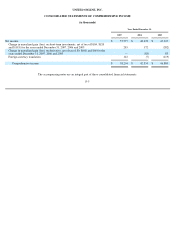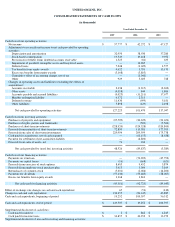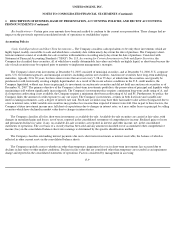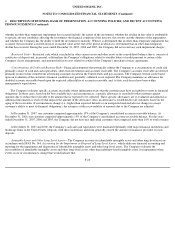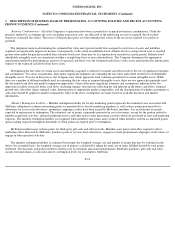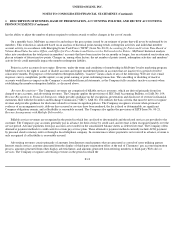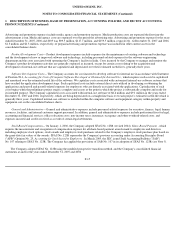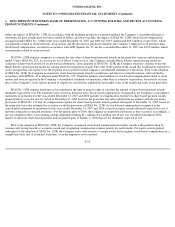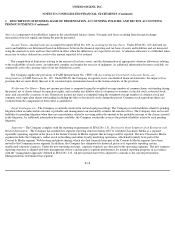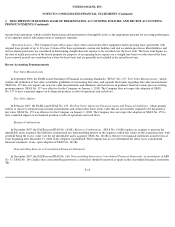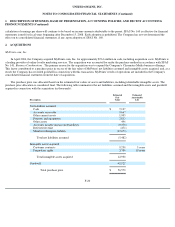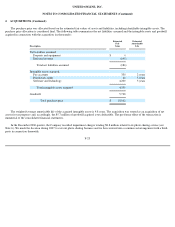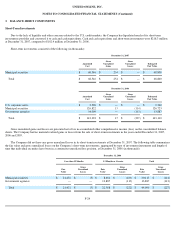Classmates.com 2007 Annual Report Download - page 96
Download and view the complete annual report
Please find page 96 of the 2007 Classmates.com annual report below. You can navigate through the pages in the report by either clicking on the pages listed below, or by using the keyword search tool below to find specific information within the annual report.
UNITED ONLINE, INC.
NOTES TO CONSOLIDATED FINANCIAL STATEMENTS (Continued)
1. DESCRIPTION OF BUSINESS, BASIS OF PRESENTATION, ACCOUNTING POLICIES, AND RECENT ACCOUNTING
PRONOUNCEMENTS (Continued)
advertisement is displayed or, for performance-based arrangements, when the related performance criteria are met. In determining whether an
arrangement exists, the Company ensures that a binding contract is in place, such as a standard insertion order or a fully executed customer-
specific agreement. The Company assesses whether performance criteria have been met and whether the fees are fixed or determinable based on
a reconciliation of the performance criteria and the payment terms associated with the transaction. The reconciliation of the performance criteria
generally includes a comparison of internally tracked performance data to the contractual performance obligation and, when available, to third-
party or customer-provided performance data.
Advertising revenues for the Company's loyalty marketing service consist primarily of fees generated when emails are transmitted to
members, when members respond to emails and when members complete online transactions. Each of these activities is a discrete, independent
activity, which generally is specified in the sales agreement for each advertising customer. As the earning activities take place, activity
measurement data (examples include the number of emails delivered and the number of responses received) is accumulated and the related
revenue is recorded.
Probability of collection is assessed based on a number of factors, including past transaction history with the customer and the
creditworthiness of the customer. If it is determined that collection is not reasonably assured, revenue is not recognized until collection becomes
reasonably assured, which is generally upon receipt of cash. Deferred revenue also represents invoiced services that have not yet been
performed.
Cost of Revenues— Cost of revenues includes telecommunications and data center costs; costs of providing rewards to members of our
loyalty marketing service; personnel- and overhead-related costs associated with operating our networks and data centers; depreciation of
network computers and equipment; email technical support and license fees; costs related to providing telephone technical support; customer
billing and billing support to our pay accounts; fees associated with the storage and processing of customer credit cards and associated bank fees;
and domain name registration fees. Historically, the costs that comprise the Company's Classmates Media cost of revenues have been relatively
fixed. However, as a result of the Company's loyalty marketing service, which was acquired in April 2006, our cost of revenues has become
more variable as the costs associated with this service tend to fluctuate with revenues. The majority of the costs that comprise the Company's
Communications cost of revenues are variable. As such, the Company's Communications cost of revenues as a percentage of revenues is highly
dependent on average monthly revenue per pay account ("ARPU"), average hourly telecommunications cost and usage, and average customer
billing and billing support costs per pay account.
Sales and Marketing— Sales and marketing expenses include expenses associated with promoting the Company's services and with
generating advertising revenues. Expenses associated with promoting the Company's services include advertising and promotion expenses; fees
paid to distribution partners, third-party advertising networks and co-registration partners to acquire new pay and free accounts; personnel and
overhead-related expenses for marketing personnel; and telemarketing costs incurred to acquire and retain pay accounts and up-
sell pay accounts
to additional services. Expenses associated with generating advertising revenues include sales commissions and personnel-related expenses. The
Company has expended significant amounts on sales and marketing, including branding and customer acquisition campaigns consisting of
television, Internet, sponsorships, radio, print and outdoor advertising, and on retail and other performance-based distribution relationships.
Marketing and advertising costs to promote the Company's products and services are expensed in the period incurred.
F-14


